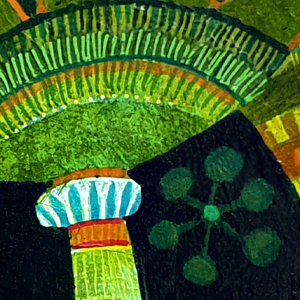
Good Engineering
Civic Virtue among Engineers
Erhardt Graeff
Artwork: “Delphinium 3” by Dan Bennett © 2009
My undergraduates at Olin College of Engineering want to make a positive impact. They see engineering as a career path to building a better world. Their initial theories of change are often naive. But I want them to hold onto the hope of positive impact through four years of equations, prototypes, and internships, and feel like they can live their values wherever their careers take them.
A Culture of Disengagement
The fields of engineering and computing have been experiencing a rightful reckoning with the negative impacts of emerging technologies. Their traditional models of personal, professional, and corporate ethics have long been lacking. Now citizens and their governments are realizing their inadequacy.
New research, curriculum, and ethics codes have emerged in response to the global focus on technology ethics. I’ve participated in countless conferences and meetings with scholars, educators, and practitioners trying to figure out how higher education can cultivate the necessary critical mindsets and ethical skills of technologists. I’ve introduced many of the novel ideas, frameworks, and approaches into the design, computer science, and social science courses I teach.
I’m reaching some students, but not all, and not always in the ways I hope to. Student reactions seem to fall into a few, rough categories: (1) Woah! Engineers have done some really bad things. I don’t want to be an engineer anymore. (2) Ethics and responsibility seem important, but it doesn’t seem relevant to the kind of engineering I want to do. (3) You can’t anticipate how people will misuse technology. This is just the cost of innovation and progress. (4) Building technology in an ethical way sounds like exactly what I want to do. But I’m not seeing job postings for “Ethical Engineer.” Can I get a job doing this?
Sadly, most reactions are not in the minor success that is Category 4. Most are in the spectrum of failure represented by Categories 1–3. In these failure modes, critical examination of how technology is created and its impacts on the world erodes responsibility and the hope of positive impact and elicits defensiveness.
Four years isn’t much time, and the mentorship my colleagues and I offer is only a sliver of the learning experiences students will have during their undergraduate education. I want to make the most of it. I want to increase the likelihood that I cultivate their fragile hope and equip them with sophisticated theories of change.
My motivation for studying and promoting civic-mindedness in engineering education arises partly from sociologist Erin Cech’s survey research showing students’ commitments to public welfare concerns erode after their first year of undergraduate engineering.1 She argues this is a result of “a culture of disengagement in engineering education.”2 Olin was one of the schools she studied, afflicted by a culture of disengagement despite its innovative pedagogy.
I take pride in Olin’s history of innovation in undergraduate engineering education, with its longstanding emphasis on project-based learning, human-centered design, and entrepreneurial thinking. The college was incorporated by the Franklin W. Olin Foundation in 1997 “to establish a new paradigm for engineering education.”3 In their petition letter to the Massachusetts Board of Education, the Foundation directors emphasized how they “see a future in which an undergraduate engineering education becomes the true ‘Liberal Education,’ i.e. an education which liberates one to lead a personal and professional life of full citizenship in one’s local, national and global communities.”4
I believe the next chapter of engineering education requires making good on the promise of a liberal education and recommitting to a holistic definition of higher education’s public purpose. Engineers may run experiments in a vacuum, but their work does not exist in one. There is no dualistic separation of social and technical concerns as Cech and decades of science and technology studies scholarship note. This demands we prepare engineering and computing students in ways that integrate their personal and professional identities into what educational philosopher Carolin Kreber calls an “authentic professional identity.”5
Authenticity and Civic Professionalism
Authenticity for Kreber is an integral part of the Aristotelian concept of eudaimonia, often translated as “human flourishing.” Living to one’s fullest potential requires living in accordance with one’s values—living authentically. I find Kreber’s book Educating for Civic-Mindedness compelling because her goal is reinvigorating professional education by emphasizing its public purpose—to cultivate civic professionals who practice their professions authentically.
For Kreber, civic-mindedness is “an overarching professional capability.”6 She builds her definition on the ideas of theorists Harry Boyte and Albert Dzur. Boyte’s “citizen professional” does not readily distinguish between their civic identity and their professional identity; they understand their work to be about strengthening communities and aim to co-create and jointly solve public problems with other citizens.7 Rather than playing the role of technocratic custodian, Dzur’s “democratic professional” similarly shares power with citizens—the many people who have a stake in professional decision-making.8 This is the external component of civic professionals, which according to Kreber must be synthesized with the internal self-cultivation of virtue to achieve an authentic professional identity, relying on:
Openness to experience, allowing professionals to cope with the uncertainties and challenges of their work,
Moral commitment, driving professionals to use critical reflection to work towards a more just world, and
Responsible community engagement, connecting professionals to their communities and motivating them to work for the common good.
Kreber leans on Aristotle and Martha Nussbaum for her definitions of virtue. But for engineers, it’s imperative to update our ideas of virtue in the way Shannon Vallor does in her book Technology and the Virtues. Vallor argues that emerging technologies pose unprecedented ethical challenges.9 Our traditional virtue frameworks are not up to the task of promoting human flourishing in a world interconnected by opaque sociotechnical systems. I want to touch on 4 of her 12 technomoral virtues that resonate strongly with how I have been adapting civic professionalism: Humility, Courage, Care, and Civility.
- Technomoral Humility involves recognizing the limits of one’s own knowledge and understanding of complex technosocial systems, being mindful of the potential for unintended negative consequences, and avoiding techno-optimism or solutionism.10
- Technomoral Care is “a skillful, attentive, responsible, and emotionally responsive disposition to personally meet the needs of those with whom we share our technosocial environment.”11
- Technomoral Courage is the willingness to take considered risks and to speak up against injustice and unethical practices in the development and use of technology. This can mean making difficult decisions, challenging powerful interests, or simply refusing to go along with the crowd.12
- Technomoral Civility involves valuing and engaging in ethical, communal life with one’s fellow citizens. It goes beyond mere politeness and requires actively fostering understanding, cooperation, and respect across diverse perspectives and cultures.13
Cultivating Civic Virtue through Experiential Learning
So how can we cultivate these virtues in our students? Kreber argues civic professionalism can be fostered through transformative educational experiences. These experiences should be action-oriented, provide opportunities for students to engage with their communities, and challenge their assumptions about the role of technology in society. For the past five years, I’ve been trying to create such learning experiences with my Olin students both outside and inside the curriculum.
In 2019, several students and I co-founded a public interest technology clinic.14 The students named it “PInT.” I have served as faculty advisor, facilitated discussions, guided students toward resources, and provided administrative and intellectual support. However, I also intentionally relinquished control to students, emphasizing student leadership and ownership of the clinic. I wanted them to wrestle with key organizational decisions and work through the complexity of managing client relationships.
The founding team wanted to create a space for students to develop more than technical skills, and to explore the social and ethical dimensions of engineering work not covered in most of their courses. They chose to foster a culture of care within PInT, prioritizing emotional well-being and open communication, which contrasted with their previous experiences in technical spaces where emotional expression was often discouraged. They created a supportive environment that encouraged vulnerability, empathy, and honest feedback.
PInT challenged the traditional engineering emphasis on rapid work and efficiency by encouraging thoughtful reflection and deliberation. Students critically examined the potential consequences of their work, moving beyond a narrow focus on technical solutions. In their clinic work, they engaged in meaningful dialogue with community partners, considering the needs and perspectives of all stakeholders.
Having ownership of PInT fostered a sense of responsibility and agency for the students, helping them see themselves as active agents of change. This encouraged them to confront uncertainty and ambiguity and develop the confidence to navigate complex situations without relying solely on faculty guidance.
The founding of PInT and the experiences of the student organizers turned out to be a potent case of transformative education, integrating civic professionalism into engineering education. By fostering a culture of care, deliberation, and student ownership,15 PInT provided opportunities for the students to develop technomoral virtues such as humility, care, courage, and civility, and enabled them to engage in responsible innovation and confront ethical challenges effectively.
One of PInT’s first clinic teams, working on the issue of human trafficking, acutely demonstrates how students developed civic-mindedness and technomoral courage. The team was asked to design a web scraper for an anti-trafficking organization. They started by looking at the technical challenges of scraping and storing images from sites known to advertise trafficked women. As I coached this team, I encouraged them to research the larger context of sex work and the use of technology to address trafficking. They learned about the potential harm to sex workers, whose data would be collected and shared with law enforcement without ensuring their safety and well-being, and the ethical implications of designing technology that could be used for surveillance and potentially contribute to the criminalization of vulnerable populations.
As a result of their research, deep conversations, and reflection, the team refused to design the web scraper. They communicated their decision to their partner in a detailed letter, discussing their research insights and discomfort with the approach the organization was taking. They also produced an event for their fellow Olin students where they presented on their project and the choices they made, encouraging others to “design no harm.”
As the students involved in the project would later confess, they thought they were failing by taking this route. While they might be reducing the chances of potential harm, they also weren’t helping anyone as they had intended. And being one of the early clinic partnerships, they felt a responsibility to model what the public interest technology clinic was created to do.
Their design refusal exemplifies technomoral courage. They put into practice emerging commitments to prioritizing the well-being of those potentially affected by their work, as highlighted by Vallor’s concept of care and Kreber’s emphasis on moral commitment; critically evaluating the ethical implications of technology beyond its intended use, recognizing the potential for unintended consequences, exercising humility and perspective; and taking a stand against powerful institutions and advocating for justice, even when it meant defying expectations or jeopardizing partnerships.
Lessons I’ve learned from advising PInT have deeply informed how I teach capstone design students. From 2019–2024, I advised a capstone project focused on designing data tools with community partners to address racialized mass incarceration in Massachusetts. The criminal legal system is a complex sociotechnical system rife with ethical pitfalls—fertile ground for experiential education. I witnessed many of my capstone students have transformative experiences in meetings with our community partners, comprehending the injustices of the current criminal legal system, and wrestling with our responsibility as engineers and civic actors when proposed solutions seemed insignificant against the scale of the problems.
We endeavored to never reduce our project to its technical dimensions. I encouraged the students to spend time diving into the social, political, and ethical realities, and to get uncomfortable. Kreber cites the transformative potential of what educational philosopher Ronald Barnett calls “strangeness”—the tensions we want students to wrangle with as they digest novel ideas and frameworks.16
I agree with Kreber that civic-mindedness should be a core outcome of higher education. And I believe community-engaged, experiential learning might be the most reliable way to cultivate civic virtue in engineering education and challenge cultures of disengagement. I hope higher education can summon the courage to advance a virtuous model of STEM professionalism. We desperately need civic professionals with technomoral wisdom to build the systems that will ensure we all flourish.
Notes
- Cech, Erin A. “Culture of Disengagement in Engineering Education?” Science, Technology, & Human Values, vol. 39, no. 1, Jan. 2014, pp. 42–72.
- Ibid., p. 65.
- Milas, Lawrence W., et al. Petition to the Board of Higher Education, Pursuant to 610 CMR 2.00 (Degree Granting Regulations for Independent Institutions of Higher Education). 6 Oct. 1997, p. 3.
- Ibid., p. 5.
- Kreber, Carolin, Educating for Civic-Mindedness. Routledge, 2016, p. 9.
- Ibid.
- Boyte, Harry C. “Citizen Professionals.” The Citizen Solution: How You Can Make A Difference, Minnesota Historical Society Press, 2008, pp. 143–57.
- Dzur, Albert W. Democracy Inside: Participatory Innovation in Unlikely Places. Oxford University Press, 2018.
- Vallor, Shannon. Technology and the Virtues: A Philosophical Guide to a Future Worth Wanting. Oxford University Press, 2016.
- Ibid., pp. 125–127.
- Ibid., pp. 138–140.
- Ibid., pp. 129–132.
- Ibid., pp. 140–145.
- See Chowdhary, Shreya, et al. “Care and Liberation in Creating a Student-Led Public Interest Technology Clinic.” 2020 IEEE International Symposium on Technology and Society (ISTAS), 2020, pp. 164–75.
- Ibid.
- Barnett, Ronald. “Recapturing the Universal in the University.” Educational Philosophy and Theory, vol. 37, no. 6, 2005, pp. 785–97.
 Erhardt Graeff is an Associate Professor of Social and Computer Science at Franklin W. Olin College of Engineering and a faculty associate at the Edmond J. Safra Center for Ethics at Harvard University. You can find more of his work at erhardtgraeff.com.
Erhardt Graeff is an Associate Professor of Social and Computer Science at Franklin W. Olin College of Engineering and a faculty associate at the Edmond J. Safra Center for Ethics at Harvard University. You can find more of his work at erhardtgraeff.com.
Spring 2025
Part I: Defining Virtue
James Arthur
Dayna L. Cunningham
Greg Lukianoff
Najeeba Syeed
Interlude: Defining Moments
Part II: Defining Vocation
MORE
















